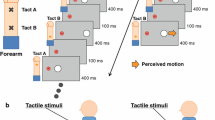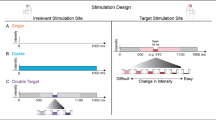Abstract
Several recent studies of crossmodal perception have demonstrated that the presentation of task-irrelevant auditory stimuli can modulate the number of tactile stimuli that a person perceives. In the present study, we attempted to extend these findings concerning audiotactile interactions in human information processing to a touch screen device. Two experiments were conducted in order to address the following research questions: 1) Can the presentation of task-irrelevant sounds be used to modify the perception of the number of tactile pulses delivered via a touch-screen device? 2) Do task-irrelevant auditory stimuli have a more pronounced effect on the tactile perception of numerosity when the task conditions become more attentionally-demanding (i.e., under conditions of dual-tasking)? The results of both experiments demonstrate that the presentation of task-irrelevant sounds can modulate the number of vibrotactile targets that a participant will perceive. What is more, task-irrelevant sounds had a larger effect on tactile perception when the participants had to perform a secondary attention-demanding task at the same time.
Similar content being viewed by others
References
Ely B (2006) Ten things that will change the way we live. Forbes.com. Available via http://www.forbes.com/lifestyle/2006/02/16/sony-sun-cisco-cx_cd_0217feat_ls.html, Feb. 2006
Logitech (2008) G25 racing wheel. Available via http://www.logitech.com/index.cfm/gaming/pc_gaming/wheels/devices/131&cl=us,en
BMW Professional Development (2003) The new 5 series IDrive. BMW of North America, LLC, Woodcliff Lake
Brewster S, Chohan F, Brown L (2007) Tactile feedback for mobile interactions. In: Proceedings of the SIGCHI conference on human factors in computing systems (CHI 2007), pp 159–162
Brown L, Brewster S, Purchase H (2005) A first investigation into the effectiveness of tactons. In: Proceeding of world haptics 2005, pp 167–176
Lee JC, Dietz P, Leigh D et al (2004) Haptic pen: a tactile feedback stylus for touch screens. In: Proceedings of the ACM symposium on user interfaces software and technology 2004, pp 291–294
Kristoffersen S, Ljungberg F (1999) “Making place” to make IT work: empirical explorations of HCI for mobile CSCW. In: Proceeding of SIGGROUP’99. ACM, New York, pp 276–285
Kunkel P (1999) Digital dreams: the work of the Sony design center. Universe Books, p 208
Poupyrev I, Maruyama S (2003) Tactile interfaces for small touch screens. In: UIST 2003, ACM symposium on user interface software and technology, CHI Letters, vol 5, pp 217–220
Hoggan E, Brewster S (2006) Crossmodal icons for information display. In: CHI 2006, ACM conference on human factors in computing systems, pp 857–862
Lee JH, Spence C (2008) Assessing the benefits of multimodal feedback on dual-task performance under demanding conditions. In: Proceeding of human computer interaction 2008, pp 185–192
Deatherage BH (1972) Auditory and other sensory forms of information processing. In: Van Cott HP, Kinkade RG (eds) Human engineering guide to equipment design. Wiley, New York, pp 124–160
Brown L, Brewster S, Purchase H (2005) A first investigation into the effectiveness of tactons. In: Proceedings of world haptics 2005, pp 167–176
Calvert GA, Spence C, Stein BE (eds) (2004) The handbook of multisensory processing. MIT Press, Cambridge
Spence C, Driver J (eds) (2004) Crossmodal space and crossmodal attention. Oxford University Press, Oxford
Shams L, Kamitani Y, Shimojo S (2000) What you see is what you hear. Nature 408:788
Shams L, Kamitani Y, Shimojo S (2002) Visual illusion induced by sound. Cogn Brain Res 14:147–152
Violentyev A, Shimojo S, Shams L (2005) Touch-induced visual illusion. Neuroreport 16:1107–1110
Hötting K, Röder B (2004) Hearing cheats touch, but less in congenitally blind than in sighted individuals. Psychol Sci 15:60–64
Bresciani JP, Ernst MO, Drewing K et al. (2005) Feeling what you hear: auditory signals can modulate tactile tap perception. Exp Brain Res 162:172–180
Bresciani JP, Ernst MO (2007) Signal reliability modulates auditory-tactile integration for event counting. Neuroreport 18:1157–1161
Wozny DR, Beierholm UR, Shams L (2008) Human trimodal perception follows optimal statistical inference. J Vis 8:1–11
Bresciani JP, Dammeier F, Ernst MO (2008) Tri-modal integration of visual, tactile and auditory signals for the perception of sequences of events. Brain Res Bull 75:753–760
Hötting K, Friedrich CK, Röder B (2008) Hearing cheats tactile deviant-detection: an event-related potential study. Poster presented at the 9th Annual meeting of the international multisensory research forum, Hamburg, Germany, 16–19 July 2008
Senkowski D, Schneider TR, Foxe JJ, Engel AK (2008) Crossmodal binding through neural coherence: implications for multisensory processing. Trends Neurosci 31:401–409
Chapman CE, Bushnell MC, Miron D, Duncan GH, Lund JP (1987) Sensory perception during movement in man. Exp Brain Res 68:516–524
Gallace A, Tan HZ, Spence C (2006) The failure to detect tactile change: a tactile analogue of visual change blindness. Psychon Bull Rev 13:300–303
Spence C, Ranson J, Driver J (2000) Crossmodal selective attention: on the difficulty of ignoring sounds at the locus of visual attention. Percept Psychophys 62:410–424
Lécuyer A, Burkhardt J-M, Etienne L (2004) Feeling bumps and holes without a haptic interface: the perception of pseudo-haptic textures. In: CHI 2004, ACM conference on human factors in computing systems, CHI Letters, vol 6, pp 239–246
Barnard PJ (1991) Connecting psychological theory to HCl: science, craft or just plain craftiness? In: IEE colloquium on theory in human-computer interaction (HCI), London, UK, 17 Dec 1991
Kitagawa N, Spence C (2006) Audiotactile multisensory interactions in human information processing. Jpn Psychol Res 48:158–173
Spence C (2007) Audiovisual multisensory integration. Acoust Sci Technol 28:61–70
Lee J-H, Spence C (2008) Spatiotemporal visuotactile interaction. In: Lecture notes in computer science, vol 5024. Springer, Berlin, pp 826–831
Kitagawa N, Kato M, Kashino M (2008) Voluntary action improves auditory-somatosensory crossmodal temporal resolution. Poster presented at the 9th Annual meeting of the international multisensory research forum, Hamburg, Germany, 16–19 July 2008
Author information
Authors and Affiliations
Corresponding author
Rights and permissions
About this article
Cite this article
Lee, JH., Spence, C. Feeling what you hear: task-irrelevant sounds modulate tactile perception delivered via a touch screen. J Multimodal User Interfaces 2, 145 (2008). https://doi.org/10.1007/s12193-009-0014-8
Received:
Accepted:
Published:
DOI: https://doi.org/10.1007/s12193-009-0014-8




